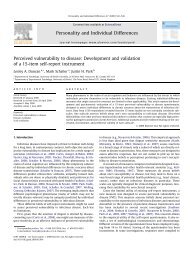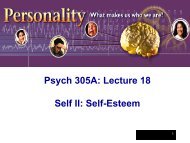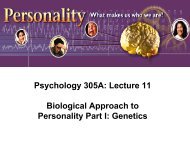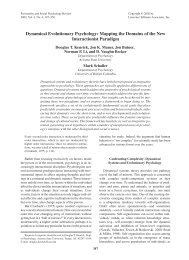Culture and the Self: Implications for Cognition, Emotion, and ... - iacmr
Culture and the Self: Implications for Cognition, Emotion, and ... - iacmr
Culture and the Self: Implications for Cognition, Emotion, and ... - iacmr
Create successful ePaper yourself
Turn your PDF publications into a flip-book with our unique Google optimized e-Paper software.
242 HAZEL ROSE MARKUS AND SHINOBU KITAYAMA<br />
The self-related motives. The motive to maintain a positive<br />
view of <strong>the</strong> self is one motive that psychologists since James<br />
(1890) through Greenwald (1980), Harter (1983), Steele (1988),<br />
<strong>and</strong> Tesser (1986) have assumed to be universally true. What<br />
constitutes a positive view of self depends, however, on one's<br />
construal of <strong>the</strong> self. 6 For those with independent selves, feeling<br />
good about oneself typically requires fulfilling <strong>the</strong> tasks associated<br />
with being an independent self; that is, being unique,<br />
expressing one's inner attributes, <strong>and</strong> asserting oneself (see Table<br />
1). Although not uncontested, a reasonable empirical generalization<br />
from <strong>the</strong> research on self-related motives is that Westerners,<br />
particularly those with high self-esteem, try to enhance<br />
<strong>the</strong>mselves whenever possible, <strong>and</strong> this tendency results in a<br />
pervasive self-serving bias. Studies with American subjects demonstrate<br />
that <strong>the</strong>y take credit <strong>for</strong> <strong>the</strong>ir successes, explain away<br />
<strong>the</strong>ir failures, <strong>and</strong> in various ways try to aggr<strong>and</strong>ize <strong>the</strong>mselves<br />
(e.g., Gilovich, 1983; Lau, 1984; J. B. Miller, 1986; Whitley &<br />
Frieze, 1985; Zuckerman, 1979). Maintaining self-esteem requires<br />
separating oneself from o<strong>the</strong>rs <strong>and</strong> seeing oneself as different<br />
from <strong>and</strong> better than o<strong>the</strong>rs. At 4 years old, children<br />
already show a clear self-favorability bias (Harter, 1989). When<br />
asked to compare <strong>the</strong>mselves with o<strong>the</strong>rs with respect to intelligence,<br />
friendliness, or any skill, most children think <strong>the</strong>y are<br />
better than most o<strong>the</strong>rs. Wylie (1979) reported that American<br />
adults also consider <strong>the</strong>mselves to be more intelligent <strong>and</strong> more<br />
attractive than average, <strong>and</strong> Myers (1987), in a national survey<br />
of American students, found that 70% of students believe <strong>the</strong>y<br />
are above average in leadership ability, <strong>and</strong> with respect to <strong>the</strong><br />
"ability to get along with o<strong>the</strong>rs," 0% thought <strong>the</strong>y were below<br />
average, 60% thought <strong>the</strong>y were in <strong>the</strong> top 10%, <strong>and</strong> 25% thought<br />
<strong>the</strong>y were in <strong>the</strong> top 1%. Moreover, as documented by Taylor<br />
<strong>and</strong> Brown (1988), among Americans, most people feel that<br />
<strong>the</strong>y are more in control <strong>and</strong> have more positive expectations<br />
<strong>for</strong> <strong>the</strong>mselves <strong>and</strong> <strong>the</strong>ir future than <strong>the</strong>y have <strong>for</strong> o<strong>the</strong>r people.<br />
This tendency toward false uniqueness presumably derives<br />
from ef<strong>for</strong>ts of those with independent selves to maintain a<br />
positive view of <strong>the</strong>mselves.<br />
The motive to maintain a positive view of <strong>the</strong> self may assume<br />
a somewhat different <strong>for</strong>m, however, <strong>for</strong> those with interdependent<br />
selves. Feeling good about one's interdependent self<br />
may not be achieved through enhancement of <strong>the</strong> value attached<br />
to one's internal attributes <strong>and</strong> <strong>the</strong> attendant self-serving<br />
bias. Instead, positive feelings about <strong>the</strong> self should derive from<br />
fulfilling <strong>the</strong> tasks associated with being interdependent with<br />
relevant o<strong>the</strong>rs: belonging, fitting in, occupying one's proper<br />
place, engaging in appropriate action, promoting o<strong>the</strong>rs' goals,<br />
<strong>and</strong> maintaining harmony (see Table 1). This follows <strong>for</strong> at least<br />
two reasons. First, people with interdependent selves are likely<br />
to be motivated by o<strong>the</strong>r-focused emotions, such as empathy<br />
<strong>and</strong> oime (i.e., <strong>the</strong> feeling of psychological indebtedness) <strong>and</strong> to<br />
act in accordance with <strong>the</strong> perceived needs <strong>and</strong> desires of <strong>the</strong>ir<br />
partners in social relations, <strong>and</strong> this may produce a social dynamic<br />
where individuals strive to enhance each o<strong>the</strong>r's self-esteem.<br />
In such reciprocal relationships, o<strong>the</strong>r enhancement<br />
could be more instrumental to self-enhancement than direct<br />
attempts at self-enhancement because <strong>the</strong> latter are likely to<br />
isolate <strong>the</strong> individual from <strong>the</strong> network of reciprocal relationships.<br />
Second, self-esteem among those with interdependent<br />
selves may be based in some large measure on <strong>the</strong>ir capacity to<br />
exert control over <strong>the</strong>ir own desires <strong>and</strong> needs so that <strong>the</strong>y can<br />
indeed belong <strong>and</strong> fit in. As noted earlier (see also Weisz et al.,<br />
1984), such self-control <strong>and</strong> self-restraint are instrumental to<br />
<strong>the</strong> ability to flexibly adjust to social contingencies <strong>and</strong> thus are<br />
highly valued in interdependent cultures. Indeed, self-restraint<br />
toge<strong>the</strong>r with flexible adjustment is often regarded as an important<br />
sign of <strong>the</strong> moral maturity of <strong>the</strong> person.<br />
A developmental study by Yoshida, Kojo, <strong>and</strong> Kaku (1982,<br />
Study 1) has documented that self-enhancement or self-promotion<br />
are perceived quite negatively in Japanese culture. Second<br />
(7-8 years old), third (8-9 years old), <strong>and</strong> fifth graders (10-11<br />
years old) at a Japanese elementary school were asked how <strong>the</strong>ir<br />
classmates (including <strong>the</strong>mselves) would evaluate a hypo<strong>the</strong>tical<br />
peer who commented on his own superb athletic per<strong>for</strong>mance<br />
ei<strong>the</strong>r in a modest, self-restrained way or in a self-enhancing<br />
way. The evaluation was solicited on <strong>the</strong> dimension of<br />
personality ("Is he a good person?") <strong>and</strong> on <strong>the</strong> dimension of<br />
ability ("Is he good at [<strong>the</strong> relevant athletic domain]?"). As<br />
shown in Figure 4A, <strong>the</strong> personality of <strong>the</strong> modest peer was<br />
perceived much more positively than was that of <strong>the</strong> self-enhancing<br />
peer. Fur<strong>the</strong>rmore, this difference became more pronounced<br />
as <strong>the</strong> age (grade) of <strong>the</strong> respondents increased. A similar<br />
finding also has been reported <strong>for</strong> Chinese college students<br />
in Hong Kong by Bond, Leung, <strong>and</strong> Wan (1982), who found<br />
that individuals giving humble or self-effacing attributions following<br />
success were liked better than those giving self-enhancing<br />
attribution. The most intriguing aspect of <strong>the</strong> Yoshida et al.<br />
(1982) study, however, is <strong>the</strong>ir finding <strong>for</strong> <strong>the</strong> ability evaluation,<br />
which showed a complete crossover interaction (see Figure 4B).<br />
Whereas <strong>the</strong> second graders took <strong>the</strong> comment of <strong>the</strong> peer at<br />
face value, perceiving <strong>the</strong> self-enhancing peer to be more competent<br />
than <strong>the</strong> modest peer, this trend disappeared <strong>for</strong> <strong>the</strong><br />
third graders, <strong>and</strong> <strong>the</strong>n completely reversed <strong>for</strong> <strong>the</strong> fifth<br />
graders. Thus, <strong>the</strong> fifth graders perceived that <strong>the</strong> modest peer<br />
was more competent than <strong>the</strong> self-enhancing peer. These findings<br />
indicate that as children are socialized in an interdependent<br />
cultural context, <strong>the</strong>y begin to appreciate <strong>the</strong> cultural<br />
value of self-restraint <strong>and</strong>, fur<strong>the</strong>rmore, to believe in a positive<br />
association between self-restraint <strong>and</strong> o<strong>the</strong>r favorable attributes<br />
of <strong>the</strong> person not only in <strong>the</strong> social, emotional domains but also<br />
in <strong>the</strong> domains of ability <strong>and</strong> competence. Although it is certainly<br />
possible <strong>for</strong> those with independent selves to overdo <strong>the</strong>ir<br />
self-enhancement (see Schlenker & Leary, 1982), <strong>for</strong> <strong>the</strong> most<br />
part, <strong>the</strong> American prescription is to confidently display <strong>and</strong><br />
express one's strengths, <strong>and</strong> those who do so are evaluated positively<br />
(e.g., Greenwald, 1980; Mullen & Riordan, 1988).<br />
<strong>Self</strong>- or o<strong>the</strong>r-serving bias. Given <strong>the</strong> appreciation that those<br />
with interdependent selves have <strong>for</strong> self-restraint <strong>and</strong> self-control,<br />
<strong>the</strong> various self-enhancing biases that are common in Western<br />
culture may not be prevalent in many Asian cultures. In an<br />
initial examination of potential cultural variation in <strong>the</strong> tendency<br />
to see oneself as different from o<strong>the</strong>rs, Markus <strong>and</strong><br />
Kitayama (in press) administered questionnaires containing a<br />
series of false-uniqueness items to large classes of Japanese college<br />
students in Japan <strong>and</strong> to large classes of American college<br />
6 For a compelling analysis of how self-esteem is related to culture,<br />
see Solomon, Greenberg, <strong>and</strong> Pyszczynski (in press).







